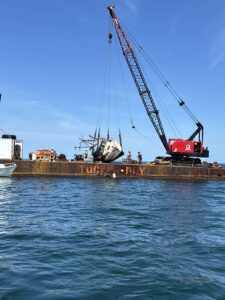ORLEANS — A Coast Guard search and rescue operation on June 11 located a 30-foot commercial dragger out of Rock Harbor that had been reported missing the day before. The F/V Seahorse was found sunken between Billingsgate Shoals and the Brewster Flats about three miles off the coast, according to Commander Cliff Graham, the Coast Guard’s Response Dept. head for Southeastern New England.

The boat’s owner and captain, Shawn Arsenault, 66, of Wellfleet, and his companion, Felicia Daley, 54, of Eastham, were found dead on board the vessel.
The cause of the wreck is still under investigation.
“We don’t know the details of what caused the incident,” Graham told the Independent on June 16. “There are a lot of common mistakes that fishermen can make to create an unstable situation.”
The search began on the morning of June 10, when Orleans Harbormaster Nate Sears reported that Arsenault’s vessel was overdue. The Seahorse, which had left the harbor on the morning of June 8, and which usually returned from fishing within a day, had not returned to port.
A multi-agency search and rescue overseen by the Coast Guard’s command center in Woods Hole involved the FBI, divers from Mass. Environmental Police, and the state police. Police departments from Hyannis, Orleans, Eastham, and Wellfleet also helped with the search, as did members of the fishing community, according to the Coast Guard’s press release.
But it was a recreational vessel that first spotted the Seahorse in about 25 feet of water southwest of Billingsgate Shoals and northwest of the Brewster Flats, Graham told the Independent.
Divers identified the vessel as the Seahorse.
The Coast Guard planned its search area and patterns using a computer program called SAROPS, the Search And Rescue Optimal Planning System, which relies on NOAA weather models and environmental data to estimate where a missing vessel might be, Graham said. “We put a 30-foot vessel into the algorithm and drifted it from Sunday to Tuesday,” he said.
Limited visibility and a low cloud ceiling prevented the Coast Guard from launching a search helicopter until the afternoon of June 10. But vessels from three Coast Guard stations were involved in the search. One from Station Provincetown and another from Station Cape Cod Canal searched in Cape Cod Bay. The third vessel, from Station Chatham, scanned the ocean side on the first day of the search.
The Coast Guard was searching the ocean side because Arsenault’s cell service provider had last pinged his phone within range of a tower “in the Chatham area,” Graham said. Cell phone providers give the Coast Guard “a general known area of the last cell phone ping” when there’s an emergency, he added.
In this case, only one tower had detected the phone. On Tuesday evening, analysts from the FBI were able to triangulate to find the cell phone’s last known location more accurately in Cape Cod Bay, near where searchers found the Seahorse the next day. Graham said it’s not unusual for the FBI to get involved in Coast Guard search and rescue operations because a cell provider’s analysis “isn’t 100 percent reliable.”
Fishermen near Rock Harbor told Sears they had seen Arsenault throw items over the side of his boat as he left on Sunday morning. Some of the witnesses speculated that Arsenault was disposing of old technology, and a radar dome and a GPS device were found on a nearby beach, CBS News Boston reported.
“The captain had reportedly just updated his vessel equipment on board,” Graham said. “He was throwing away the discarded older equipment. Someone even spoke to him and asked him to stop throwing stuff overboard.”
Arsenault’s brother told the Boston Globe that he thought the Seahorse’s dredge might have been hooked on a wreck at the bottom of the ocean. If that happened, it would have been possible for the boat to sink before anyone aboard could make a distress call. There was no distress call in this case.
That scenario seemed possible to Al Youngren, a retired fisherman and clam and scallop dredge designer in Orleans. “There’s a wire that goes up through the boom and into the dredge,” Youngren said. “If he made a small turn while he was hauling back on that wire, that would pull him over very easily.” According to Youngren, that can happen with dredges — even ones twice the size of the Seahorse.
“It’s always tragic when you lose a member of the fishing community,” said Chris Viprino, owner of the Rock Harbor Shellfish Co. in Orleans. “Hopefully it makes people reflect a little bit, go over their equipment, and try to mitigate things like this in the future.”
